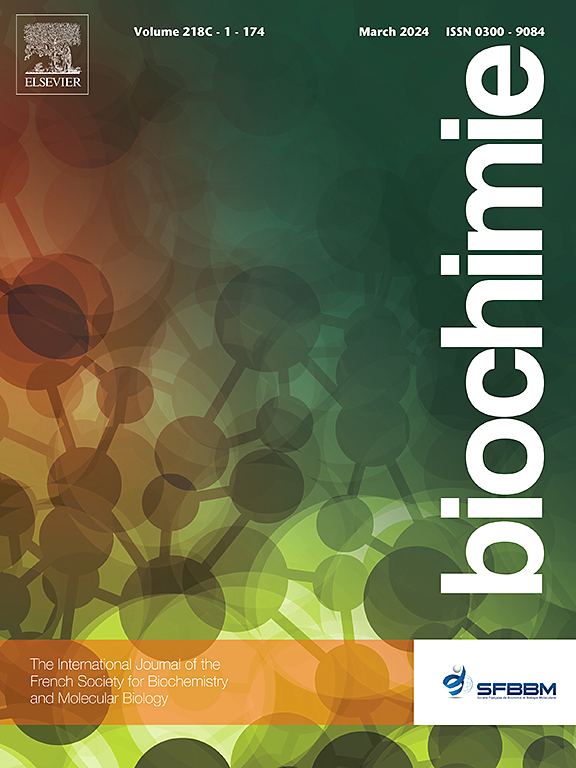Identification of lipid biomarkers at different stages of breast cancer by rapid evaporative ionization mass spectrometry (REIMS) using syngeneic balb/c mice breast cancer model
IF 3
3区 生物学
Q2 BIOCHEMISTRY & MOLECULAR BIOLOGY
引用次数: 0
Abstract
Lipid metabolite profiling of different phases, i.e., early phase (EP) and metastatic phase, was carried out to find out potential lipid biomarkers in breast cancer. Breast cancer was induced using 4T1 cells in a syngeneic mice model using balb/c mice. Rapid Evaporative Ionization Mass Spectrometry (REIMS) was employed to elucidate the lipid biomarker profile. REIMS analysis revealed 25 significant lipid metabolites with biomarker potential for breast cancer. Definite expression variations of different lipid biomarkers highlight the hallmark lipid biomarker, which in turn might be playing a crucial role in breast cancer induction and progression. Different classes of lipids, such as phospholipids, steroids, fatty acids, etc. were observed in the analysis, and they were found to participate in vital pathways including glycerophospholipid metabolism, steroid hormone biosynthesis, fructose and mannose metabolism, either lipid metabolism, glycerolipid metabolism, glycolysis/gluconeogenesis, inositol phosphate metabolism and the biosynthesis of unsaturated fatty acids, respectively, during breast cancer events. Therefore, these lipid metabolites can be considered a potential lipid biomarker for better diagnosis, such as early detection, and to design an effective breast cancer treatment in the future.
采用同基因balb/c小鼠乳腺癌模型,快速蒸发电离质谱法(rems)鉴定乳腺癌不同阶段的脂质生物标志物。
通过对不同阶段,即早期(EP)和转移期的脂质代谢谱分析,寻找乳腺癌中潜在的脂质生物标志物。用4T1细胞在balb/c小鼠的同基因小鼠模型中诱导乳腺癌。采用快速蒸发电离质谱法(rems)分析脂质生物标志物。rems分析显示,25种显著的脂质代谢物具有乳腺癌的生物标志物潜力。不同脂质生物标志物的明确表达变化突出了标志性的脂质生物标志物,这反过来可能在乳腺癌的诱导和进展中起着至关重要的作用。在分析中观察到不同种类的脂质,如磷脂、类固醇、脂肪酸等,发现它们在乳腺癌事件中分别参与了重要的途径,包括甘油磷脂代谢、类固醇激素生物合成、果糖和甘露糖代谢、脂质代谢、甘油脂代谢、糖酵解/糖异生、肌醇磷酸代谢和不饱和脂肪酸的生物合成。因此,这些脂质代谢物可以被认为是一种潜在的脂质生物标志物,用于更好的诊断,如早期发现,并在未来设计有效的乳腺癌治疗。
本文章由计算机程序翻译,如有差异,请以英文原文为准。
求助全文
约1分钟内获得全文
求助全文
来源期刊

Biochimie
生物-生化与分子生物学
CiteScore
7.20
自引率
2.60%
发文量
219
审稿时长
40 days
期刊介绍:
Biochimie publishes original research articles, short communications, review articles, graphical reviews, mini-reviews, and hypotheses in the broad areas of biology, including biochemistry, enzymology, molecular and cell biology, metabolic regulation, genetics, immunology, microbiology, structural biology, genomics, proteomics, and molecular mechanisms of disease. Biochimie publishes exclusively in English.
Articles are subject to peer review, and must satisfy the requirements of originality, high scientific integrity and general interest to a broad range of readers. Submissions that are judged to be of sound scientific and technical quality but do not fully satisfy the requirements for publication in Biochimie may benefit from a transfer service to a more suitable journal within the same subject area.
 求助内容:
求助内容: 应助结果提醒方式:
应助结果提醒方式:


